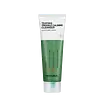What's inside
What's inside
 Key Ingredients
Key Ingredients

No key ingredients
 Benefits
Benefits

 Concerns
Concerns

 Ingredients Side-by-side
Ingredients Side-by-side

Water
Skin ConditioningGlycerin
HumectantMyristic Acid
CleansingStearic Acid
CleansingLauric Acid
CleansingPotassium Hydroxide
BufferingButylene Glycol
HumectantGlycol Distearate
EmollientGlyceryl Stearate Se
EmulsifyingSorbitan Olivate
EmulsifyingBeeswax
Emulsion StabilisingPotassium Cocoyl Glycinate
Caprylyl Glycol
EmollientCoco-Betaine
CleansingMelaleuca Alternifolia Leaf Oil
AntioxidantSodium Chloride
MaskingArtemisia Vulgaris Oil
PerfumingEthylhexylglycerin
Skin ConditioningLavandula Angustifolia Oil
MaskingCitric Acid
BufferingMelaleuca Alternifolia Leaf Extract
PerfumingCapryloyl Salicylic Acid
Exfoliating1,2-Hexanediol
Skin ConditioningMelaleuca Alternifolia Leaf Water
AntimicrobialMannitol
HumectantSodium Hyaluronate
HumectantKaolin
AbrasivePapain
Skin ConditioningHydrolyzed Hyaluronic Acid
HumectantBromelain
Skin ConditioningLactobacillus Ferment
Skin ConditioningSodium Acetylated Hyaluronate
HumectantHydrogenated Lecithin
EmulsifyingWater, Glycerin, Myristic Acid, Stearic Acid, Lauric Acid, Potassium Hydroxide, Butylene Glycol, Glycol Distearate, Glyceryl Stearate Se, Sorbitan Olivate, Beeswax, Potassium Cocoyl Glycinate, Caprylyl Glycol, Coco-Betaine, Melaleuca Alternifolia Leaf Oil, Sodium Chloride, Artemisia Vulgaris Oil, Ethylhexylglycerin, Lavandula Angustifolia Oil, Citric Acid, Melaleuca Alternifolia Leaf Extract, Capryloyl Salicylic Acid, 1,2-Hexanediol, Melaleuca Alternifolia Leaf Water, Mannitol, Sodium Hyaluronate, Kaolin, Papain, Hydrolyzed Hyaluronic Acid, Bromelain, Lactobacillus Ferment, Sodium Acetylated Hyaluronate, Hydrogenated Lecithin
Water
Skin ConditioningSodium Cocoyl Glycinate
CleansingCoco-Betaine
CleansingGlycerin
HumectantAcrylates Copolymer
Sodium Chloride
MaskingPhenoxyethanol
PreservativeCitrus Limon Peel Oil
MaskingLimonene
PerfumingSodium Hydroxide
BufferingTetrasodium EDTA
Propylene Glycol
HumectantGeranium Maculatum Oil
MaskingCitral
PerfumingCalendula Officinalis Flower Extract
MaskingCymbopogon Schoenanthus Oil
MaskingArtemisia Absinthium Extract
Skin ConditioningCitric Acid
BufferingWater, Sodium Cocoyl Glycinate, Coco-Betaine, Glycerin, Acrylates Copolymer, Sodium Chloride, Phenoxyethanol, Citrus Limon Peel Oil, Limonene, Sodium Hydroxide, Tetrasodium EDTA, Propylene Glycol, Geranium Maculatum Oil, Citral, Calendula Officinalis Flower Extract, Cymbopogon Schoenanthus Oil, Artemisia Absinthium Extract, Citric Acid
 Reviews
Reviews

Ingredients Explained
These ingredients are found in both products.
Ingredients higher up in an ingredient list are typically present in a larger amount.
Citric Acid is an alpha hydroxy acid (AHA) naturally found in citrus fruits like oranges, lemons, and limes.
Like other AHAs, citric acid can exfoliate skin by breaking down the bonds that hold dead skin cells together. This helps reveal smoother and brighter skin underneath.
However, this exfoliating effect only happens at high concentrations (20%) which can be hard to find in cosmetic products.
Due to this, citric acid is usually included in small amounts as a pH adjuster. This helps keep products slightly more acidic and compatible with skin's natural pH.
In skincare formulas, citric acid can:
While it can provide some skin benefits, research shows lactic acid and glycolic acid are generally more effective and less irritating exfoliants.
Most citric acid used in skincare today is made by fermenting sugars (usually from molasses). This synthetic version is identical to the natural citrus form but easier to stabilize and use in formulations.
Read more about some other popular AHA's here:
Learn more about Citric AcidCoco-Betaine is the natural version of Cocamidopropyl Betaine. It is often derived from coconuts.
Coco-Betaine is a surfactant, meaning it helps remove dirt and oil from the skin.
Glycerin is already naturally found in your skin. It helps moisturize and protect your skin.
A study from 2016 found glycerin to be more effective as a humectant than AHAs and hyaluronic acid.
As a humectant, it helps the skin stay hydrated by pulling moisture to your skin. The low molecular weight of glycerin allows it to pull moisture into the deeper layers of your skin.
Hydrated skin improves your skin barrier; Your skin barrier helps protect against irritants and bacteria.
Glycerin has also been found to have antimicrobial and antiviral properties. Due to these properties, glycerin is often used in wound and burn treatments.
In cosmetics, glycerin is usually derived from plants such as soybean or palm. However, it can also be sourced from animals, such as tallow or animal fat.
This ingredient is organic, colorless, odorless, and non-toxic.
Glycerin is the name for this ingredient in American English. British English uses Glycerol/Glycerine.
Learn more about GlycerinChances are, you eat sodium chloride every day. Sodium Chloride is also known as table salt.
This ingredient has many purposes in skincare: thickener, emulsifier, and exfoliator.
You'll most likely find this ingredient in cleansers where it is used to create a gel-like texture. As an emulsifier, it also prevents ingredients from separating.
There is much debate on whether this ingredient is comedogenic. The short answer - comedogenic ratings don't tell the whole story. Learn more about comegodenic ratings here.
The concensus about this ingredient causing acne seems to be divided. Research is needed to understand if this ingredient does cause acne.
Scrubs may use salt as the primary exfoliating ingredient.
Learn more about Sodium ChlorideWater. It's the most common cosmetic ingredient of all. You'll usually see it at the top of ingredient lists, meaning that it makes up the largest part of the product.
So why is it so popular? Water most often acts as a solvent - this means that it helps dissolve other ingredients into the formulation.
You'll also recognize water as that liquid we all need to stay alive. If you see this, drink a glass of water. Stay hydrated!
Learn more about Water